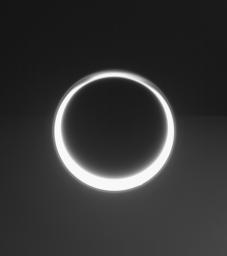
|
Amazing Hazes
- Click the image above for a larger view
- Full-Res JPEG (822 x 929) (18.9 kB)
- Full-Res TIFF (822 x 929) (764.7 kB)
Caption:
Sunlight streams through the high-altitude haze layer that extends completely around the giant moon, Titan, in this view of the moon taken by the Cassini spacecraft. Some fine structure can be spotted in the ever-shifting hazes in Titan's northern polar reaches to the top.
The distant sky beyond Titan (5,150 kilometers, or 3,200 miles across) is not empty, but instead is filled in the lower half by the barely visible, immense bulk of Saturn 1.3 million kilometers (800,000 miles) beyond. The view is toward the night side of both worlds.
Titan's image is saturated, or over exposed, near the five o'clock position, obscuring the details in the atmosphere.
The image was taken in visible light with the Cassini spacecraft narrow-angle camera on June 2, 2006 at a distance of approximately 2.3 million kilometers (1.4 million miles) from Titan and at a Sun-Titan-spacecraft, or phase, angle of 163 degrees. Image scale is 14 kilometers (9 miles) per pixel on Titan.
Background Info:
The Cassini-Huygens mission is a cooperative project of NASA, the European Space Agency and the Italian Space Agency. The Jet Propulsion Laboratory, a division of the California Institute of Technology in Pasadena, manages the mission for NASA's Science Mission Directorate, Washington, D.C. The Cassini orbiter and its two onboard cameras were designed, developed and assembled at JPL. The imaging operations center is based at the Space Science Institute in Boulder, Colo.
For more information about the Cassini-Huygens mission visit http://saturn.jpl.nasa.gov/home/index.cfm . The Cassini imaging team homepage is at http://ciclops.org .
Cataloging Keywords:
| Name | Value | Additional Values |
|---|---|---|
| Target | Titan | Saturn |
| System | Saturn | |
| Target Type | Satellite | Planet |
| Mission | Cassini-Huygens | |
| Instrument Host | Cassini Orbiter | |
| Host Type | Orbiter | |
| Instrument | Imaging Science Subsystem (ISS) | |
| Detector | Narrow Angle Camera | |
| Extra Keywords | Atmosphere, Grayscale, Haze, Visual | |
| Acquisition Date | ||
| Release Date | 2006-07-05 | |
| Date in Caption | 2006-06-02 | |
| Image Credit | NASA/JPL/Space Science Institute | |
| Source | photojournal.jpl.nasa.gov/catalog/PIA08214 | |
| Identifier | PIA08214 | |
